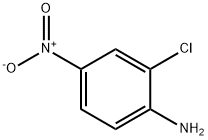| Identification | More | [Name]
2-Chloro-4-nitroaniline | [CAS]
121-87-9 | [Synonyms]
1-AMINO-2-CHLORO-4-NITROBENZENE
2-CHLORO-4-NITROANILINE
2-Chloro-4-nitrobenzenamine
2-CHLORO-4-NITRO-PHENYLAMINE
4-NITRO-2-CHLOROANILINE
LABOTEST-BB LT00030789
O-CHLORO-P-NITRO ANILINE
ocpn
OCPNA
ORTHO CHLORO PARA NITRO ANILINE
2-chloro-4-nitro-anilin
2-chloro-4-nitro-benzenamin
Benzenamine,2-chloro-4-nitro-
4-CHLORO-2-NITROANILINE, 1000MG, NEAT
2-CHLORO-4-NITROANILINE WET 97%
orthoChloro-p-Nitroaniline
o-chloro-nitroaniline
2-/-4-CHLORONITROANILIN
p-Nitro-o-chloroaniline
2-chloro-4-nitrobenzeneamine | [EINECS(EC#)]
204-502-2 | [Molecular Formula]
C6H5ClN2O2 | [MDL Number]
MFCD00007665 | [Molecular Weight]
172.57 | [MOL File]
121-87-9.mol |
| Safety Data | Back Directory | [Hazard Codes ]
Xn,N | [Risk Statements ]
R22:Harmful if swallowed.
R51/53:Toxic to aquatic organisms, may cause long-term adverse effects in the aquatic environment . | [Safety Statements ]
S22:Do not breathe dust .
S24:Avoid contact with skin .
S61:Avoid release to the environment. Refer to special instructions safety data sheet . | [RIDADR ]
UN 2237 6.1/PG 3
| [WGK Germany ]
2
| [RTECS ]
BX1400000
| [Autoignition Temperature]
971 °F | [TSCA ]
Yes | [HazardClass ]
6.1(b) | [PackingGroup ]
III | [HS Code ]
29214200 | [Hazardous Substances Data]
121-87-9(Hazardous Substances Data) | [Toxicity]
LD50 orally in Rabbit: 6430 mg/kg |
| Hazard Information | Back Directory | [General Description]
Yellow crystalline powder. | [Reactivity Profile]
2-CHLORO-4-NITROANILINE(121-87-9) can react with oxidizing materials. | [Air & Water Reactions]
Insoluble in water. | [Hazard]
Toxic by ingestion and inhalation. | [Health Hazard]
TOXIC; inhalation, ingestion or skin contact with material may cause severe injury or death. Contact with molten substance may cause severe burns to skin and eyes. Avoid any skin contact. Effects of contact or inhalation may be delayed. Fire may produce irritating, corrosive and/or toxic gases. Runoff from fire control or dilution water may be corrosive and/or toxic and cause pollution. | [Fire Hazard]
Combustible material: may burn but does not ignite readily. When heated, vapors may form explosive mixtures with air: indoors, outdoors and sewers explosion hazards. Contact with metals may evolve flammable hydrogen gas. Containers may explode when heated. Runoff may pollute waterways. Substance may be transported in a molten form. | [Chemical Properties]
yellow crystalline powder | [Synthesis Reference(s)]
The Journal of Organic Chemistry, 51, p. 5039, 1986 DOI: 10.1021/jo00375a062 |
|





